
Animals of Yellowstone
Encyclopedia
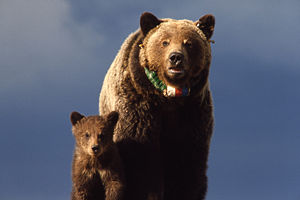
Yellowstone National Park
Yellowstone National Park, established by the U.S. Congress and signed into law by President Ulysses S. Grant on March 1, 1872, is a national park located primarily in the U.S. state of Wyoming, although it also extends into Montana and Idaho...
in the northwest United States
United States
The United States of America is a federal constitutional republic comprising fifty states and a federal district...
is home to a large variety of mammals, birds, fish
Fish
Fish are a paraphyletic group of organisms that consist of all gill-bearing aquatic vertebrate animals that lack limbs with digits. Included in this definition are the living hagfish, lampreys, and cartilaginous and bony fish, as well as various extinct related groups...
, reptiles and amphibians, many of which migrate within the Greater Yellowstone Ecosystem
Greater Yellowstone Ecosystem
The Greater Yellowstone Ecosystem is one of the last remaining large, nearly intact ecosystems in the northern temperate zone of the Earth and is partly located in Yellowstone National Park. Conflict over management has been controversial, and the area is a flagship site among conservation groups...
. These Animals of Yellowstone, especially larger mammals, birds and fish are a major park attraction.
American Bison
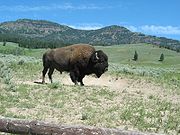
Bison
Members of the genus Bison are large, even-toed ungulates within the subfamily Bovinae. Two extant and four extinct species are recognized...
are the largest grazing mammals in Yellowstone National Park. They are strictly vegetarian, a grazer of grasslands and sedges in the meadows, the foothills, and even the high-elevation, forested plateaus of Yellowstone. Bison males, called bulls, can weigh upwards of 1,800 pounds. Females (cows) average about 1,300 pounds. Both stand approximately six feet tall at the shoulder, and can move with surprising speed to defend their young or when approached too closely by people. Bison breed from mid-July to mid-August, and bear one calf in April and May. Some wolf predation of bison is documented in Canada and has recently been observed in Yellowstone.
Yellowstone is the only place in the lower 48 states
Contiguous United States
The contiguous United States are the 48 U.S. states on the continent of North America that are south of Canada and north of Mexico, plus the District of Columbia....
where a population of wild American bison
American Bison
The American bison , also commonly known as the American buffalo, is a North American species of bison that once roamed the grasslands of North America in massive herds...
has persisted since prehistoric times, although fewer than 50 native bison remained there in 1902. Fearing extinction
Extinction
In biology and ecology, extinction is the end of an organism or of a group of organisms , normally a species. The moment of extinction is generally considered to be the death of the last individual of the species, although the capacity to breed and recover may have been lost before this point...
, the park imported 21 bison from two privately-owned herds, as foundation stock for a bison ranching project that spanned 50 years at the Lamar Buffalo Ranch
Lamar Buffalo Ranch
The Lamar Buffalo Ranch was created to preserve one of the last free-roaming bison herds in the United States. The ranch was established in 1907 when 28 bison were moved from Fort Yellowstone to the Lamar Valley in the northeast portion of the park. The herd was maintained as a semi-domesticated...
in Yellowstone's Lamar Valley
Lamar River
The Lamar River is a tributary of the Yellowstone River, approximately 40 miles long, in northwestern Wyoming in the United States. The river is located entirely within Yellowstone National Park.-History:...
. Activities there included irrigation
Irrigation
Irrigation may be defined as the science of artificial application of water to the land or soil. It is used to assist in the growing of agricultural crops, maintenance of landscapes, and revegetation of disturbed soils in dry areas and during periods of inadequate rainfall...
, hay
Hay
Hay is grass, legumes or other herbaceous plants that have been cut, dried, and stored for use as animal fodder, particularly for grazing livestock such as cattle, horses, goats, and sheep. Hay is also fed to pets such as rabbits and guinea pigs...
-feeding, roundups, culling, and predator control, to artificially ensure herd survival. By the 1920s, some intermingling of the introduced and wild bison had begun. With protection from poaching
Poaching
Poaching is the illegal taking of wild plants or animals contrary to local and international conservation and wildlife management laws. Violations of hunting laws and regulations are normally punishable by law and, collectively, such violations are known as poaching.It may be illegal and in...
, the native and transplanted populations increased. In 1936, bison were transplanted to historic habitats
Habitat (ecology)
A habitat is an ecological or environmental area that is inhabited by a particular species of animal, plant or other type of organism...
in the Firehole River
Firehole River
The Firehole River is one of two major tributaries of the Madison River. It flows north approximately from its source in Madison Lake on the Continental Divide to join the Gibbon River at Madison Junction in Yellowstone National Park...
and Hayden Valley
Hayden Valley
Hayden Valley is a large, sub-alpine valley in Yellowstone National Park straddling the Yellowstone River between Yellowstone Falls and Yellowstone Lake. The valley floor along the river is an ancient lake bed from a time when Yellowstone Lake was much larger...
. In 2003, the entire population numbered 1,477. Bison were trapped and herds periodically reduced until 1967, when only 397 bison were counted parkwide. All bison herd reduction activities were phased out after 1966, again allowing natural ecological processes to determine bison numbers and distribution. Presently, the park's bison population is estimated at about 4,000.
Bison are nomadic grazers, wandering high on Yellowstone's grassy plateaus in summer. Despite their slow gait, bison are surprisingly fast for animals that weigh more than half a ton. In winter, they use their large heads like a plow to push aside snow and find winter food. In the park interior where snows are deep, they winter in thermally influenced areas and around the geyser basins. Bison also move to winter range in the northern part of Yellowstone.
Bears
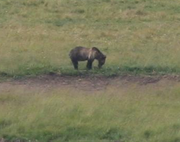
Brown Bear
The brown bear is a large bear distributed across much of northern Eurasia and North America. It can weigh from and its largest subspecies, the Kodiak Bear, rivals the polar bear as the largest member of the bear family and as the largest land-based predator.There are several recognized...
(Ursus arctos horribilis) population within the Yellowstone ecosystem is estimated to be approximately 280-610 bears. The current estimate of the black bear
American black bear
The American black bear is a medium-sized bear native to North America. It is the continent's smallest and most common bear species. Black bears are omnivores, with their diets varying greatly depending on season and location. They typically live in largely forested areas, but do leave forests in...
(Ursus americanus) population is 500-650 bears.
While in spawning streams, cutthroat trout
Cutthroat trout
The cutthroat trout is a species of freshwater fish in the salmon family of order Salmoniformes. It is one of the many fish species colloquially known as trout...
are preyed upon by numerous predators including black bears and grizzly bears. Due to their high digestibility and protein
Protein
Proteins are biochemical compounds consisting of one or more polypeptides typically folded into a globular or fibrous form, facilitating a biological function. A polypeptide is a single linear polymer chain of amino acids bonded together by peptide bonds between the carboxyl and amino groups of...
and lipid
Lipid
Lipids constitute a broad group of naturally occurring molecules that include fats, waxes, sterols, fat-soluble vitamins , monoglycerides, diglycerides, triglycerides, phospholipids, and others...
content, spawning cutthroat trout are one of the highest sources of net digestible energy for Grizzly Bears in the Yellowstone ecosystem. Cutthroat trout are an important late-spring and early-summer food
Food
Food is any substance consumed to provide nutritional support for the body. It is usually of plant or animal origin, and contains essential nutrients, such as carbohydrates, fats, proteins, vitamins, or minerals...
source for bears and may provide bears the opportunity to regain body mass after den emergence and help females with cubs meet the energetic demands of lactation.
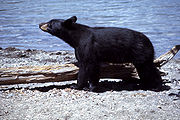
Gray Wolf
The gray wolf , also known as the wolf, is the largest extant wild member of the Canidae family...
s (Canis lupus) to Yellowstone National Park, much interest has been shown regarding the effects of a restored wolf population on both grizzly bears and black bears. Grizzly bears, black bears, and gray wolves have historically coexisted in much of the same range throughout a large portion of North America
North America
North America is a continent wholly within the Northern Hemisphere and almost wholly within the Western Hemisphere. It is also considered a northern subcontinent of the Americas...
.
Bear
Bear
Bears are mammals of the family Ursidae. Bears are classified as caniforms, or doglike carnivorans, with the pinnipeds being their closest living relatives. Although there are only eight living species of bear, they are widespread, appearing in a wide variety of habitats throughout the Northern...
s were once commonly observed along roadsides and within developed areas of Yellowstone National Park. Bears were attracted to these areas by the availability of human foods in the form of handouts and unsecured camp groceries and garbage. Although having bears readily visible along roadsides and within developed areas was very popular with the park visitors, it was also considered to be the primary cause of an average of 48 bear-caused human injuries per year from 1930 through 1969.
In 1970, the park took a gamble and initiated an intensive bear management program. The objectives of this change was restoring the grizzly bear and black bear populations to subsistence on natural forage and reducing bear-caused injuries to humans. As part of the bear management program implemented in 1970, regulations prohibiting the feeding of bears were strictly enforced. Some experts believed that the bears would not survive this change. As the bears became more desperate for food and more aggressive, more of them were encountered in camps and had to be destroyed. In the next several years, over 100 grizzly bears had to be put down, and the park bear population was on the brink of extinction. On July 28, 1975, under the authority of the Endangered Species Act
Endangered Species Act
The Endangered Species Act of 1973 is one of the dozens of United States environmental laws passed in the 1970s. Signed into law by President Richard Nixon on December 28, 1973, it was designed to protect critically imperiled species from extinction as a "consequence of economic growth and...
, the United States Fish and Wildlife Service
United States Fish and Wildlife Service
The United States Fish and Wildlife Service is a federal government agency within the United States Department of the Interior dedicated to the management of fish, wildlife, and natural habitats...
listed the grizzly bear in the lower 48 states as a threatened species
Threatened species
Threatened species are any speciesg animals, plants, fungi, etc.) which are vulnerable to endangerment in the near future.The World Conservation Union is the foremost authority on threatened species, and treats threatened species not as a single category, but as a group of three categories,...
.
Over the next several decades, the bears learned to hunt and forage for themselves from non-human food sources, and their population slowly grew. On March 22, 2007 grizzly bears were taken off of the Endangered Species list. In the 30 years since the grizzly was listed as a threatened species, the Yellowstone population increased from 126 to 500. "The grizzly is a large predator that requires a great deal of space, and conserving such animals is a challenge in today's world," Deputy Interior Secretary Lynn Scarlett said in announcing the decision. "I believe all Americans should be proud that, as a nation, we had the will and the ability to protect and restore this symbol of the wild."
From 1980-2002, over 62 million people visited Yellowstone National Park (YNP). During the same period, 32 people were injured by bears. Grizzly Bear-inflicted injuries to humans in developed areas averaged approximately 1 per year during the 1930s through the 1950s and 4 per year during the 1960s. Human injuries from black bears have decreased from averages of 46 per year from 1931–1969, to 4 per year during the 1970s and less than one (0.17) per year from 1980-2002. The chance of being injured by a bear while in the park is approximately 1 in 1.9 million. Five known bear-caused human fatalities and 1 possible fatality have occurred within the park. In addition, 1 fatality occurred in the Gallatin National Forest
Gallatin National Forest
Founded in 1899, Gallatin National Forest is located in south central Montana, United States. The forest comprises 2.1 million acres and has portions of both the Absaroka-Beartooth and Lee Metcalf Wilderness areas within its boundaries...
outside of the park.
Bighorn Sheep

Bighorn Sheep
The bighorn sheep is a species of sheep in North America named for its large horns. These horns can weigh up to , while the sheep themselves weigh up to . Recent genetic testing indicates that there are three distinct subspecies of Ovis canadensis, one of which is endangered: Ovis canadensis sierrae...
(Ovis canadensis) were once very numerous in western United States and were an important food source for humans. The "Sheepeaters", related to the Shoshone
Shoshone
The Shoshone or Shoshoni are a Native American tribe in the United States with three large divisions: the Northern, the Western and the Eastern....
tribe, lived year-round in Yellowstone until 1880. Their principal food was Bighorn Sheep and they made their bow
Bow (weapon)
The bow and arrow is a projectile weapon system that predates recorded history and is common to most cultures.-Description:A bow is a flexible arc that shoots aerodynamic projectiles by means of elastic energy. Essentially, the bow is a form of spring powered by a string or cord...
s from sheep horn
Horn (anatomy)
A horn is a pointed projection of the skin on the head of various animals, consisting of a covering of horn surrounding a core of living bone. True horns are found mainly among the ruminant artiodactyls, in the families Antilocapridae and Bovidae...
s. By 1900, during an "epoch of relentless destruction by the skin hunters", bighorn numbers were reduced to a few hundred in the United States. In 1897 about 100-150 were estimated to be present in the park. By 1912, despite a disease (scab
Scab
Scab can refer to the following:* Scab, a hard coating on the skin formed during the wound healing reconstruction phase* Derogatory term for a strikebreaker, a person who works despite strike action or against the will of other employees...
) contracted from domestic sheep
Domestic sheep
Sheep are quadrupedal, ruminant mammals typically kept as livestock. Like all ruminants, sheep are members of the order Artiodactyla, the even-toed ungulates. Although the name "sheep" applies to many species in the genus Ovis, in everyday usage it almost always refers to Ovis aries...
, bighorns in the park had increased to more than 200 and travelers could find them with fair certainty by devoting a few days to searching around Mount Everts
Mount Everts
Mount Everts el. is a prominent mountain peak in Yellowstone National Park, Wyoming near Mammoth Hot Springs. The peak was named for Truman C. Everts, a member of the Washburn–Langford–Doane Expedition of 1870. Mount Everts is located immediately due south of Gardiner, Montana and due east of...
, Mount Washburn
Mount Washburn
Mount Washburn el. is a prominent mountain peak in the Washburn Range in Yellowstone National Park, Wyoming. The peak was named in 1870 to honor Henry D. Washburn, leader of the Washburn–Langford–Doane Expedition...
or other well-known ranges. In winter, small bands of sheep could then be seen every day between Mammoth and Gardiner.
Bobcats
In the early years of the 20th century, bobcatBobcat
The bobcat is a North American mammal of the cat family Felidae, appearing during the Irvingtonian stage of around 1.8 million years ago . With twelve recognized subspecies, it ranges from southern Canada to northern Mexico, including most of the continental United States...
s (Lynx rufus) were reported as "somewhat common" in the park. There have 9 to 14 reported sightings each decade since 1960. These sightings have occurred throughout the park; about 80 percent have occurred in the northern half. Bobcats have been reported in about equal numbers during all seasons. In 1960, a bobcat was killed by a car near Squaw Lake (now Indian Pond) on the north shore of Yellowstone Lake; its skull
Skull
The skull is a bony structure in the head of many animals that supports the structures of the face and forms a cavity for the brain.The skull is composed of two parts: the cranium and the mandible. A skull without a mandible is only a cranium. Animals that have skulls are called craniates...
was deposited in the Yellowstone Museum collection. Other roadkilled bobcats were reported in 1993 and 1996. In 1960, a young bobcat was reported on the porch of the administration building at Mammoth; other young bobcats have been reported at Pebble Creek bridge (February 1977) and at Canyon campground (July 1986), where one accompanied an adult bobcat.
No research has been conducted in Yellowstone to determine the numbers or distribution of this elusive animal that usually is solitary, nocturnal, and widely scattered over its range.
Unlike lynx, which they resemble, bobcats elsewhere have been highly adaptable to human-caused changes in environmental conditions; some biologists believe that there are more bobcats in the United States today than in colonial times. Yellowstone has many rock outcrops, canyons bordered by rock ledges, conifer forests, and semi-open areas that seem to offer conditions favorable for bobcats—adequate shelter, a variety of rodents, rabbits, hares, birds, and other small animals as well as seasonal carrion, for food. Carrion is seldom used if live prey is available. Studies elsewhere have shown that bobcats also may kill both young and adult antelope and deer; they stalk bedded adults and may be carried long distances while biting their prey in the neck.
Visitors are advised to report any sightings of bobcats or bobcat tracks to a ranger or visitor center. For animals so seldom recorded, every observation is considered useful and important.
Canada lynx
The Canada LynxCanada Lynx
The Canada lynx or Canadian lynx is a North American mammal of the cat family, Felidae. It is a close relative of the Eurasian Lynx . Some authorities regard both as conspecific. However, in some characteristics the Canada lynx is more like the bobcat than the Eurasian Lynx...
is listed as a threatened species
Threatened species
Threatened species are any speciesg animals, plants, fungi, etc.) which are vulnerable to endangerment in the near future.The World Conservation Union is the foremost authority on threatened species, and treats threatened species not as a single category, but as a group of three categories,...
under the Endangered Species Act
Endangered Species Act
The Endangered Species Act of 1973 is one of the dozens of United States environmental laws passed in the 1970s. Signed into law by President Richard Nixon on December 28, 1973, it was designed to protect critically imperiled species from extinction as a "consequence of economic growth and...
. Biologists studying the Lynx in Yellowstone believe it has persisted in the park in some number since the park's creation in 1872. A four year study completed in 2005 concluded there is a small resident population of Lynx in the park, but it is rarely seen directly or indirectly (tracks) by either biologists or visitors.
Coyotes
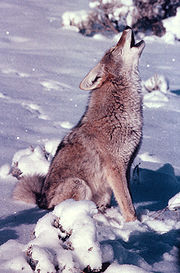
Coyote
The coyote , also known as the American jackal or the prairie wolf, is a species of canine found throughout North and Central America, ranging from Panama in the south, north through Mexico, the United States and Canada...
s (Canis latrans) are among the largest coyotes in the United States; adults average about 30 pounds (13–14 kg). and some weigh around 40 pounds (18 kg).
Coyotes live an average of about 6 years, although one Yellowstone coyote lived to be more than 13 before she was killed and eaten by a cougar. The coyote is a common predator in the park, often seen alone or in packs, traveling through the park's wide open valleys hunting small mammals. But they are widely distributed and their sign can also be found in the forest
Forest
A forest, also referred to as a wood or the woods, is an area with a high density of trees. As with cities, depending where you are in the world, what is considered a forest may vary significantly in size and have various classification according to how and what of the forest is composed...
s and thermal areas throughout Yellowstone. They are capable of killing large prey, especially when they cooperatively hunt.
The reintroduction of wolves in 1995 has significantly decreased the coyote population, although those who remain often scavenge from wolf kills. Throughout the restoration project, coyote research has continued, with an eye toward identifying the interactions between coyotes and wolves and on assessing the effects of wolves on coyote populations. During planning and environmental assessment of the effects of wolf restoration, biologists anticipated that coyotes would compete with the larger canid, perhaps resulting in disruption of packs and numerical declines.
Coyotes occasionally lose their wariness of humans and frequent roadsides or developed areas, becoming conditioned to human food by receiving handouts or picking up food scraps. They can quickly learn bad habits like roadside begging behavior. This leads to potential danger for humans and coyotes. Several instances of coyote aggression toward humans have occurred in the park, including one that involved an actual attack. Habituation most likely played a role in this unusual coyote behavior.
Elk
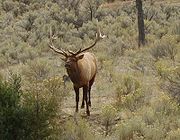
Elk
The Elk is the large deer, also called Cervus canadensis or wapiti, of North America and eastern Asia.Elk may also refer to:Other antlered mammals:...
or Wapiti (Cervus canadensis) are the most abundant large mammal
Mammal
Mammals are members of a class of air-breathing vertebrate animals characterised by the possession of endothermy, hair, three middle ear bones, and mammary glands functional in mothers with young...
found in Yellowstone; paleontological evidence confirms their continuous presence for at least 1,000 years. Yellowstone National Park was established in 1872, when market hunting of all large grazing animals was rampant. Not until after 1886, when the United States Army
United States Army
The United States Army is the main branch of the United States Armed Forces responsible for land-based military operations. It is the largest and oldest established branch of the U.S. military, and is one of seven U.S. uniformed services...
was called in to protect the park and wildlife slaughter was brought under control, did the large animals increase in number.
More than 30,000 elk from 7-8 different herds summer in Yellowstone and approximately 15,000 to 22,000 winter in the park. The subspecies of elk that lives here are found from Arizona
Arizona
Arizona ; is a state located in the southwestern region of the United States. It is also part of the western United States and the mountain west. The capital and largest city is Phoenix...
to northern Canada
Canada
Canada is a North American country consisting of ten provinces and three territories. Located in the northern part of the continent, it extends from the Atlantic Ocean in the east to the Pacific Ocean in the west, and northward into the Arctic Ocean...
along the Rocky Mountain chain; other species of elk were historically distributed from coast to coast, but disappeared from the eastern United States in the early 19th century. Some other subspecies of elk still occupy coastal regions of California
California
California is a state located on the West Coast of the United States. It is by far the most populous U.S. state, and the third-largest by land area...
, Washington, and Oregon
Oregon
Oregon is a state in the Pacific Northwest region of the United States. It is located on the Pacific coast, with Washington to the north, California to the south, Nevada on the southeast and Idaho to the east. The Columbia and Snake rivers delineate much of Oregon's northern and eastern...
. Elk are the second largest member of the deer
Deer
Deer are the ruminant mammals forming the family Cervidae. Species in the Cervidae family include white-tailed deer, elk, moose, red deer, reindeer, fallow deer, roe deer and chital. Male deer of all species and female reindeer grow and shed new antlers each year...
family (moose are larger). Adult males, or bulls, range upwards of 700 pounds (~320 kg) while females, or cows, average 500-525 pounds (~225–240 kg). Their coats are reddish brown with heavy, darker-colored manes and a distinct yellowish rump patch.
Bulls grow antlers annually from the time they are nearly one year old. When mature, a bull’s "rack" may have 6 to 8 points or tines on each side and weigh more than 30 pounds. The antlers are usually shed in March or April, and begin regrowing in May, when the bony growth is nourished by blood vessels and covered by furry-looking "velvet." Antler growth ceases each year by August, when the velvet dries up and bulls begin to scrape it off by rubbing against trees, in preparation for the autumn mating season or rut. A bull may gather 20-30 cows into his harem during the mating season, often clashing or locking antlers with another mature male for the privilege of dominating the herd group. By November, mating season ends and elk generally move to their winter ranges. Calves weighing 25-40 pounds are born in late May or early June.
Moose

Moose
The moose or Eurasian elk is the largest extant species in the deer family. Moose are distinguished by the palmate antlers of the males; other members of the family have antlers with a dendritic configuration...
(Alces alces shirasi Nelson), the largest member of the deer family, were reportedly very rare in northwest Wyoming
Wyoming
Wyoming is a state in the mountain region of the Western United States. The western two thirds of the state is covered mostly with the mountain ranges and rangelands in the foothills of the Eastern Rocky Mountains, while the eastern third of the state is high elevation prairie known as the High...
when Yellowstone National Park was established in 1872. Subsequent protection from hunting and wolf control programs may have contributed to increased numbers but suppression of forest fire
Fire
Fire is the rapid oxidation of a material in the chemical process of combustion, releasing heat, light, and various reaction products. Slower oxidative processes like rusting or digestion are not included by this definition....
s probably was the most important factor, since moose here depend on mature fir forests for winter survival.
Surveys in the late 1980s suggested a total park population of fewer than 1000 moose. The moose calf crop has been declining since the fires of 1988. During that summer there was also high predation of moose by grizzly bears in small patches of surviving timber. The winter following the fires many old moose died, probably as a combined result of the loss of good moose forage and a harsh winter. The fires forced some moose into poorer habitats, with the result that some almost doubled their home range, using deeper snow areas than previously, and sometimes browsing burned lodgepole pines.
Moose are commonly observed in the park's southwestern corner along the Bechler
Bechler River
The Bechler River is a remote major river flowing southwest entirely within the confines of Yellowstone National Park to it confluence with the Fall River in the southwest section of the park. The river was named by Frank Bradley, a member of the 1872 Hayden Geological Survey for Gustavus R....
and Fall river
Fall River (Wyoming, Idaho)
Fall River rises on the Madison and Pitchstone plateaus in the southwest corner of Yellowstone National Park, Wyoming and flows approximately to its confluence with the Henrys Fork of the Snake River near Ashton, Idaho...
s, in the riparian zones around Yellowstone Lake
Yellowstone Lake
Yellowstone Lake is the largest body of water in Yellowstone National Park, The lake is 7,732 feet above sea level and covers with 110 miles of shoreline. While the average depth of the lake is 139 feet its deepest spot is at least 390 feet...
, in the Soda Butte Creek
Soda Butte Creek
Soda Butte Creek is an approximately long major tributary of the Lamar River in Yellowstone National Park. It is named for an unusual geologic feature near its mouth. Soda Butte and the creek were named by A. Bart Henderson, a Cooke City miner, in 1870...
, Pelican Creek, Lewis River
Lewis River (Wyoming)
The Lewis River is an tributary of the Snake River. The entire course of the river is located within the boundaries of Yellowstone National Park in Wyoming. The river is named for Meriwether Lewis, commander of the Lewis and Clark Expedition....
, and Gallatin River
Gallatin River
The Gallatin River is a tributary of the Missouri River, approximately 120 mi , in the U.S. states of Wyoming and Montana...
drainages, and in the Willow Park area between Mammoth and Norris. Summer moose migrations from south and west of the park into Yellowstone have been confirmed by radio telemetry.
Mountain Goats
Mountain goatMountain goat
The Mountain Goat , also known as the Rocky Mountain Goat, is a large-hoofed mammal found only in North America. Despite its vernacular name, it is not a member of Capra, the genus of true goats...
s (Oreamnos americanus) are not native in the park but were introduced into the Absaroka Range
Absaroka Range
The Absaroka Range is a sub-range of the Rocky Mountains in the United States. The range stretches about 150 mi across the Montana-Wyoming border, forming the eastern boundary of Yellowstone National Park and the western side of the Bighorn Basin. The range borders the Beartooth Mountains...
in Montana in the 1940s. They migrated into the park and breeding populations established themselves in the northwestern and northeastern regions of the park in the 1990s. As of 2008, the number of goats in and adjacent to the park is estimated to be 175–225. This colonization of a non-native species has raised concerns about adverse effects on alpine habitats. Surveys in 2002 and 2003 suggest that ridgetop vegetation cover is lower, and barren areas along alpine ridges are more prevalent in areas with relatively high goat use. Competition with high densities of mountain goats could also negatively affect bighorn sheep, whose range overlaps with mountain goats.
Mountain Lions
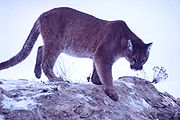
Cat
The cat , also known as the domestic cat or housecat to distinguish it from other felids and felines, is a small, usually furry, domesticated, carnivorous mammal that is valued by humans for its companionship and for its ability to hunt vermin and household pests...
family living in Yellowstone. Mountain lions can weigh up to 200 pounds (~90 kg), although lions in Yellowstone are thought to range between 140 and 160 pounds (~65 and ~70 kg) for males and around 100 pounds (45 kg) for females. Two to three kittens may be born at any time of year, although most arrive in summer and fall. For reasons that are not clear, only about 50 percent of kittens survive their first year. The current population of lions in Yellowstone is estimated to be 18-24 animals and is thought to be increasing.
Mountain lions were significantly reduced by predator control measures during the early 20th century. It is reported that 121 lions were removed from the park between the years 1904 and 1925. At that time, the remaining population was estimated to be 12 individuals. Mountain lions apparently existed at very low numbers between 1925 and 1940. Reports of lions in Yellowstone have increased steadily from 1 each year between 1930 and 1939 to about 16 each year between 1980 and 1988. However, increases in visitor travel in Yellowstone and improvements in record keeping during this period probably contributed to this trend.
In 1987, the first study of mountain lion ecology was initiated in Yellowstone National Park. The research documented population dynamics of mountain lions in the northern Yellowstone ecosystem inside and outside the park boundary, determined home ranges and habitat requirements, and assessed the role of lions as a predator in the ecosystem. In recent years in other areas of the West, mountain lions have occasionally attacked humans. No documented lion/human confrontations have occurred in Yellowstone.
Mule Deer and White-tailed Deer
The mule deerMule Deer
The mule deer is a deer indigenous to western North America. The Mule Deer gets its name from its large mule-like ears. There are believed to be several subspecies, including the black-tailed deer...
(Odocoileus hemionus) is a deer
Deer
Deer are the ruminant mammals forming the family Cervidae. Species in the Cervidae family include white-tailed deer, elk, moose, red deer, reindeer, fallow deer, roe deer and chital. Male deer of all species and female reindeer grow and shed new antlers each year...
whose habitat is in the western half of North America
North America
North America is a continent wholly within the Northern Hemisphere and almost wholly within the Western Hemisphere. It is also considered a northern subcontinent of the Americas...
. It gets its name from its large mule
Mule
A mule is the offspring of a male donkey and a female horse. Horses and donkeys are different species, with different numbers of chromosomes. Of the two F1 hybrids between these two species, a mule is easier to obtain than a hinny...
-like ears. In Yellowstone mule deer are commonly found in forests, grasslands, and shrub lands.
The white-tailed deer
White-tailed Deer
The white-tailed deer , also known as the Virginia deer or simply as the whitetail, is a medium-sized deer native to the United States , Canada, Mexico, Central America, and South America as far south as Peru...
(Odocoileus virginianus) occurs in aspen parklands and deciduous river bottomlands within the central and northern Great Plains, and in mixed deciduous riparian corridors, river valley bottomlands, and lower foothills of the northern Rocky Mountain regions from Wyoming to southeastern British Columbia. It is an occasional visitor to these habitats in the Yellowstone region.
Gray Wolf
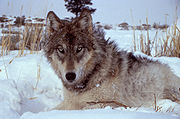
Gray Wolf
The gray wolf , also known as the wolf, is the largest extant wild member of the Canidae family...
(Canis lupus), were native to Yellowstone when the park was established in 1872. Predator control was practiced in the late 19th and early 20th centuries. Between 1914 and 1926, at least 136 wolves were killed in the park; by the 1940s, wolf packs were rarely reported. By the 1970s, scientists found no evidence of a wolf population in Yellowstone; wolves persisted in the lower 48 states only in northern Minnesota and on Isle Royale in Michigan. Canadian Grey Wolves were introduced into Yellowstone in 1995. This move has returned wolves to land that was once ruled by the canine. They currently exist in several packs, the largest of which are the Slough Creek, Yellowstone Delta, and Leopold packs. The Wolves had to "re-learn" an instinct that their ancestors once had: hunting bison. Being used to the elk in Canada, the wolves were dumbfounded by the large, burly buffalo found all over Yellowstone. They have made many appearances on National Geographic Channel Documentaries.
The United States Fish and Wildlife Service provides weekly updates on the wolves of the Rocky Mountain region including wolves of Yellowstone.
Small Mammals
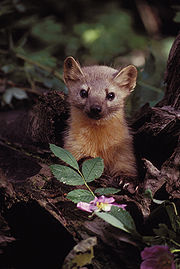
Bat
Bats are mammals of the order Chiroptera "hand" and pteron "wing") whose forelimbs form webbed wings, making them the only mammals naturally capable of true and sustained flight. By contrast, other mammals said to fly, such as flying squirrels, gliding possums, and colugos, glide rather than fly,...
s: Big Brown Bat
Big brown bat
The Big Brown Bat is larger in size than comparative species of bats, from about 4 to 5 inches in body length, with a 11-13 inch wingspan and weighing 1/2 to 5/8 ounce. The fur is moderately long, and shiny brown...
, Little Brown Bat
Little brown bat
The little brown bat is a species of the genus Myotis , one of the most common bats of North America...
, Long-legged Bat
Long-legged Myotis
The Long-Legged Myotis is a species of vesper bat in the Vespertilionidae family.It can be found in Alberta and British Columbia in Canada, Mexico, and the western United States....
, and Silver-haired bat
Silver-Haired Bat
The Silver-haired Bat is a species of vesper bat in the family Vespertilionidae and the only member of the genus Lasionycteris.- Habitat :...
. Squirrel
Squirrel
Squirrels belong to a large family of small or medium-sized rodents called the Sciuridae. The family includes tree squirrels, ground squirrels, chipmunks, marmots , flying squirrels, and prairie dogs. Squirrels are indigenous to the Americas, Eurasia, and Africa and have been introduced to Australia...
, Rabbit
Rabbit
Rabbits are small mammals in the family Leporidae of the order Lagomorpha, found in several parts of the world...
, vole
Vole
A vole is a small rodent resembling a mouse but with a stouter body, a shorter hairy tail, a slightly rounder head, smaller ears and eyes, and differently formed molars . There are approximately 155 species of voles. They are sometimes known as meadow mice or field mice in North America...
, mice
MICE
-Fiction:*Mice , alien species in The Hitchhiker's Guide to the Galaxy*The Mice -Acronyms:* "Meetings, Incentives, Conferencing, Exhibitions", facilities terminology for events...
, and shrew
Shrew
A shrew or shrew mouse is a small molelike mammal classified in the order Soricomorpha. True shrews are also not to be confused with West Indies shrews, treeshrews, otter shrews, or elephant shrews, which belong to different families or orders.Although its external appearance is generally that of...
species are common, but many are nocturnal and rarely seen by visitors. The Uinta ground squirrel
Uinta ground squirrel
The Uinta ground squirrel , commonly called a Potgut in northern Utah, is a native of the northern Rocky Mountains and surrounding foothills of the United States including Idaho, Montana, Utah, and Wyoming...
, Least Chipmunk
Least Chipmunk
The least chipmunk is the smallest chipmunk in North America. It is also the most widespread species of chipmunk in North America occurring across north-central and western United States and from British Columbia and southern Yukon to western Quebec in Canada...
, Golden-mantled ground squirrel
Golden-mantled Ground Squirrel
The golden-mantled ground squirrel, Callospermophilus lateralis, is a type of ground squirrel found in mountainous areas of western North America. It eats seeds, nuts, berries, insects, and underground fungi. It is preyed upon by hawks, jays, weasels, foxes, bobcats, and coyotes. A typical adult...
and American Red Squirrel
American Red Squirrel
The American Red Squirrel is one of three species of tree squirrel currently classified in the genus Tamiasciurus and known as pine squirrels...
are commonly encountered by park visitors.
Weasel
Weasel
Weasels are mammals forming the genus Mustela of the Mustelidae family. They are small, active predators, long and slender with short legs....
species, including the North American River Otter are prevalent in the park. Beaver
Beaver
The beaver is a primarily nocturnal, large, semi-aquatic rodent. Castor includes two extant species, North American Beaver and Eurasian Beaver . Beavers are known for building dams, canals, and lodges . They are the second-largest rodent in the world...
were almost trapped out of the park region prior to its creation. In 1998, beaver populations are making a comeback and an estimated 500 beavers were living in the park with the densest colonial in the Bechler River
Bechler River
The Bechler River is a remote major river flowing southwest entirely within the confines of Yellowstone National Park to it confluence with the Fall River in the southwest section of the park. The river was named by Frank Bradley, a member of the 1872 Hayden Geological Survey for Gustavus R....
and Fall River
Fall River (Wyoming, Idaho)
Fall River rises on the Madison and Pitchstone plateaus in the southwest corner of Yellowstone National Park, Wyoming and flows approximately to its confluence with the Henrys Fork of the Snake River near Ashton, Idaho...
region, the Yellowstone River
Yellowstone River
The Yellowstone River is a tributary of the Missouri River, approximately long, in the western United States. Considered the principal tributary of the upper Missouri, the river and its tributaries drain a wide area stretching from the Rocky Mountains in the vicinity of the Yellowstone National...
delta above Yellowstone Lake
Yellowstone Lake
Yellowstone Lake is the largest body of water in Yellowstone National Park, The lake is 7,732 feet above sea level and covers with 110 miles of shoreline. While the average depth of the lake is 139 feet its deepest spot is at least 390 feet...
and the lower Madison River
Madison River
The Madison River is a headwater tributary of the Missouri River, approximately 183 miles long, in Wyoming and Montana. Its confluence with the Jefferson and Gallatin rivers near Three Forks, Montana form the Missouri River....
and its tributarys
Birds

Bald Eagle
The Bald Eagle is a bird of prey found in North America. It is the national bird and symbol of the United States of America. This sea eagle has two known sub-species and forms a species pair with the White-tailed Eagle...
s, Trumpeter Swan
Trumpeter Swan
The Trumpeter Swan, Cygnus buccinator, is the largest native North American bird, if measured in terms of weight and length, and is the largest living waterfowl species on earth. It is the North American counterpart of the European Whooper Swan.-Description:Males typically measure from and weigh...
s, Common Loons, Osprey
Osprey
The Osprey , sometimes known as the sea hawk or fish eagle, is a diurnal, fish-eating bird of prey. It is a large raptor, reaching more than in length and across the wings...
s, American White Pelican
American White Pelican
The American White Pelican is a large aquatic bird from the order Pelecaniformes. It breeds in interior North America, moving south and to the coasts, as far as Central America, in winter....
s, and Sandhill Crane
Sandhill Crane
The Sandhill Crane is a large crane of North America and extreme northeastern Siberia. The common name of this bird references habitat like that at the Platte River, on the edge of Nebraska's Sandhills in the American Midwest...
s. The extensive rivers, lakes and wetlands are summer homes to large numbers of waterfowl
Waterfowl
Waterfowl are certain wildfowl of the order Anseriformes, especially members of the family Anatidae, which includes ducks, geese, and swans....
, while the forests and meadows host many different species of warbler
Warbler
There are a number of Passeriformes called "warblers". They are not particularly closely related, but share some characteristics, such as being fairly small, vocal and insectivorous....
s, sparrow
Sparrow
The sparrows are a family of small passerine birds, Passeridae. They are also known as true sparrows, or Old World sparrows, names also used for a genus of the family, Passer...
s and other passerine
Passerine
A passerine is a bird of the order Passeriformes, which includes more than half of all bird species. Sometimes known as perching birds or, less accurately, as songbirds, the passerines form one of the most diverse terrestrial vertebrate orders: with over 5,000 identified species, it has roughly...
birds.
Amphibians and Reptiles
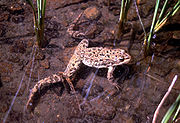
Glacier
A glacier is a large persistent body of ice that forms where the accumulation of snow exceeds its ablation over many years, often centuries. At least 0.1 km² in area and 50 m thick, but often much larger, a glacier slowly deforms and flows due to stresses induced by its weight...
activity and current cool and dry conditions are likely responsible for their relatively low numbers in Yellowstone.
Although no Yellowstone reptile or amphibian species are currently listed as threatened or endangered, several — including the Boreal Toad — are thought to be declining in the West. Surveys and monitoring are underway to try to determine if amphibian populations are declining in Yellowstone National Park.
Cool, dry conditions limit Yellowstone's reptiles to six species and population numbers for these species are not known. Known reptile species in the park: prairie rattlesnake
Crotalus viridis
Crotalus viridis is a venomous pitviper species native to the western United States, southwestern Canada, and northern Mexico. Currently, nine subspecies are recognized, including the nominate subspecies described here.-Description:...
(Crotalis viridis viridis), Bullsnake
Bullsnake
The bullsnake ' is a large non-venomous colubrid snake, widespread in the central part of the United States, northern Mexico, and southwestern Saskatchewan and Alberta Canada. It is currently considered a subspecies of the gopher snake '...
(Pituophis catenifer sayi), valley garter snake
Common Garter Snake
The Common Garter Snake is a snake indigenous to North America. Most garter snakes have a pattern of yellow stripes on a brown or green background and their average length is about , maximum about .-Subspecies:...
(Thamnophis sirtalis fitchi), wandering garter snake
Western Terrestrial Garter Snake
The Western terrestrial garter snake is a species of colubrid snake.Seven subspecies are currently recognized.-Description:...
(Thamnophis elegans vagrans), rubber boa
Rubber Boa
The Rubber Boa is a snake in the family Boidae that is native to the Western United States.-Taxonomy:The Rubber Boa is a snake in the family Boidae and genus Charina. The name Charina is from the Greek for graceful or delightful, and the name bottae honors Dr. Paolo E. Botta, an Italian ship's...
(Charina bottae), sagebrush lizard (Sceloporus graciosus graciosus).
In 1991 park staff began cooperating with researchers from Idaho State University
Idaho State University
Idaho State University is a public university located in Pocatello, Idaho. It has outreach programs in Coeur d'Alene, Idaho Falls, Boise, and Twin Falls....
to sample additional park habitats for reptile
Reptile
Reptiles are members of a class of air-breathing, ectothermic vertebrates which are characterized by laying shelled eggs , and having skin covered in scales and/or scutes. They are tetrapods, either having four limbs or being descended from four-limbed ancestors...
s and amphibians. This led to establishment of long-term monitoring sites in the park. The relatively undisturbed nature of the park and the baseline data may prove useful in testing hypotheses concerning the apparent declines of several species
Species
In biology, a species is one of the basic units of biological classification and a taxonomic rank. A species is often defined as a group of organisms capable of interbreeding and producing fertile offspring. While in many cases this definition is adequate, more precise or differing measures are...
of toad
Toad
A toad is any of a number of species of amphibians in the order Anura characterized by dry, leathery skin , short legs, and snoat-like parotoid glands...
s and frog
Frog
Frogs are amphibians in the order Anura , formerly referred to as Salientia . Most frogs are characterized by a short body, webbed digits , protruding eyes and the absence of a tail...
s in the western United States. Reptile and amphibian population declines may be caused by such factors as drought
Drought
A drought is an extended period of months or years when a region notes a deficiency in its water supply. Generally, this occurs when a region receives consistently below average precipitation. It can have a substantial impact on the ecosystem and agriculture of the affected region...
, pollution
Pollution
Pollution is the introduction of contaminants into a natural environment that causes instability, disorder, harm or discomfort to the ecosystem i.e. physical systems or living organisms. Pollution can take the form of chemical substances or energy, such as noise, heat or light...
, disease
Disease
A disease is an abnormal condition affecting the body of an organism. It is often construed to be a medical condition associated with specific symptoms and signs. It may be caused by external factors, such as infectious disease, or it may be caused by internal dysfunctions, such as autoimmune...
, predation
Predation
In ecology, predation describes a biological interaction where a predator feeds on its prey . Predators may or may not kill their prey prior to feeding on them, but the act of predation always results in the death of its prey and the eventual absorption of the prey's tissue through consumption...
, habitat loss and fragmentation, introduced fish
Fish
Fish are a paraphyletic group of organisms that consist of all gill-bearing aquatic vertebrate animals that lack limbs with digits. Included in this definition are the living hagfish, lampreys, and cartilaginous and bony fish, as well as various extinct related groups...
and other non-native species.

Fish

Yellowstone Lake
Yellowstone Lake is the largest body of water in Yellowstone National Park, The lake is 7,732 feet above sea level and covers with 110 miles of shoreline. While the average depth of the lake is 139 feet its deepest spot is at least 390 feet...
supports the largest inland population of cutthroat trout in the world, and is the core of the remaining undisturbed habitat for native Yellowstone cutthroat trout
Yellowstone cutthroat trout
The Yellowstone cutthroat trout is a subspecies of the cutthroat trout and is a freshwater fish in the salmon family of the order Salmoniformes. Native only to a few U.S...
(Oncorhynchus clarki bouvieri) in the Yellowstone ecosystem. Each spring, cutthroat trout migrate from the lake to its tributaries to spawn
Spawn (biology)
Spawn refers to the eggs and sperm released or deposited, usually into water, by aquatic animals. As a verb, spawn refers to the process of releasing the eggs and sperm, also called spawning...
.
Yellowstone cutthroat trout generally declined in the second half of the 20th century due to angler overharvest, competition with exotic fishes
Introduced species
An introduced species — or neozoon, alien, exotic, non-indigenous, or non-native species, or simply an introduction, is a species living outside its indigenous or native distributional range, and has arrived in an ecosystem or plant community by human activity, either deliberate or accidental...
, and overzealous egg
Ovum
An ovum is a haploid female reproductive cell or gamete. Both animals and embryophytes have ova. The term ovule is used for the young ovum of an animal, as well as the plant structure that carries the female gametophyte and egg cell and develops into a seed after fertilization...
collection. Populations rebounded in the park after the advent of catch-and-release-only fishing rules in the 1970s, but new and aggressive invaders are causing an increasing threat to these native fish and alarming park fisheries biologists. Nonnative lake trout
Lake trout
Lake trout is a freshwater char living mainly in lakes in northern North America. Other names for it include mackinaw, lake char , touladi, togue, and grey trout. In Lake Superior, they can also be variously known as siscowet, paperbellies and leans...
, an effective fish predator, were discovered in Yellowstone Lake in 1994. Throughout the west cutthroat trout populations preyed upon by introduced lake trout have typically declined, exhibited lower growth, or have disappeared. Aggressive lake trout control efforts by the National Park Service and no harvest limits have resulted in removing thousands of lake trout from Yellowstone Lake since 1994, including more than 12,000 in 2000. Still, the number of Yellowstone cutthroat trout monitored during the annual fall count in Yellowstone Lake was lower in recent years than at any other time in the 25-year history of the monitoring effort. Whirling disease, which has been implicated in recent years in the decline of trout populations in many western states, was discovered in Yellowstone Lake in 1998. So far, it is unclear which of these two nonnative invaders has been the greater factor in the decline of Yellowstone cutthroat trout, but there is no question they are causing it.
Yellowstone cutthroat trout have declined throughout the west and are currently designated as a "Species of Special Concern-Class A" by the American Fisheries Society. A formal petition to list this subspecies as "threatened" throughout its range was submitted to the U.S. Fish and Wildlife Service in 1998. Yellowstone National Park represents approximately 91% of the current range of Yellowstone cutthroat trout and contains 85% of the historical lake habitat for this subspecies, so the park is considered crucial to the survival of the species.
Other native sport fish, including westslope cutthroat trout
Westslope cutthroat trout
The westslope cutthroat trout , also known as the blackspotted cutthroat, is a subspecies of the cutthroat trout and is a freshwater fish in the salmon family of order Salmoniformes. The cutthroat is the Montana state fish...
and Montana grayling
Arctic grayling
Arctic grayling is a species of freshwater fish in the salmon family of order Salmoniformes. It comprises five subspecies native to the Nearctic and Palearctic ecozones. T. a. arcticus is widespread throughout the Arctic and Pacific drainages in Canada, Alaska, and Siberia, as well as the upper...
, have been under catch-and-release-only fishing rules since 1973. This is the first time mountain whitefish
Mountain whitefish
The mountain whitefish is one of the most widely distributed salmonid fish of western North America. It is found from the Mackenzie River drainage in Northwest Territory, Canada south through western Canada and the northwestern USA in the Pacific, Hudson Bay and upper Missouri River basins to the...
have been placed under such rules in Yellowstone National Park. The new rule gives mountain whitefish equal status to the other native sport fish in the park.

